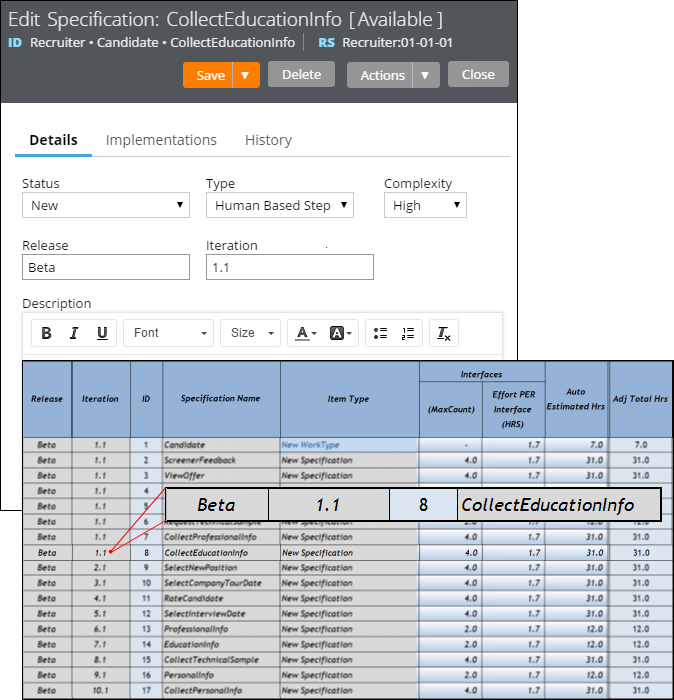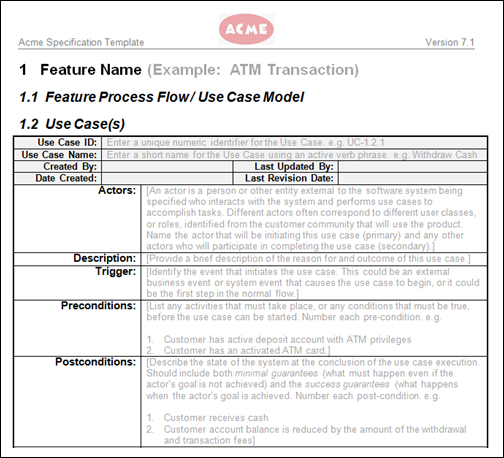Tracked changes persist between client sessions
Valid from Pega Version 7.1.7
The Microsoft Word native change tracking feature persists between client sessions for specifications. Enable this feature to facilitate collaborative reviews of your specifications with project stakeholders.
Inserting your specification updates as tracked changes allows you to:
- Provide visible markup to the next reviewer.
- Correlate edits to a specific user and time.
- Generate documents that include markup and comments.
Local settings, such as the colors you specify for markup, do not persist between clients.
For instructions on how to prevent markup and comments from appearing in generated documents, see Advanced options for editing specifications.
Add multiple attachments at once
Valid from Pega Version 7.1.7
You can now add more than one attachment to a requirement or specification at a time, without closing the Add/Edit Attachment modal dialog box. Use the traditional browse method to upload an attachment or drag and drop a local file, based on your needs. View and access your attachments from the Application Profile landing page, Requirement form, or Specification form.
Plan projects using release data
Valid from Pega Version 7.1.7
Requirements and specifications can now be mapped to a target release and iteration within a specific release. Populating these fields allows you to set and publish a release schedule through worksheets generated by the Sizing wizard. Access these fields from the Application Profile landing page or by opening any requirement or specification.

The Release and Iteration fields as they appear in a specification and a corresponding worksheet
The Sizing wizard incorporates values from the Release and Iteration fields for specifications only.
Specification type extended for decisioning users
Valid from Pega Version 7.1.7
Specifications now support a Decision Strategy Manager (DSM) type. This allows you to map your specifications to a decisioning component, such as a strategy or model. After you select an appropriate subtype and provide relevant metadata, you can run the Sizing wizard to incorporate these details into project sizing worksheets.

DSM specification details as they appear in the Specification form and Sizing wizard output
You must have access to Decision Management rulesets to create DSM specifications. For more information on specification types, refer to the Details tab of the Specification form. To view all specifications in your application, filtered by type, refer to the Application Profile landing page.
Add collections as linked implementations
Valid from Pega Version 7.1.7
You can now identify a collection or individual steps within a collection as an implementation of a specification. Linking specifications to rules allows you to more accurately convey your application design to project stakeholders. Use the Specifications tab on the Collection form to create these links.
To see all implementations for a given specification, refer to the Application Profile landing page or the Implementations tab of the Specification form.
Add project branding to generated documents
Valid from Pega Version 7.1.7
The standard Word Template for specification descriptions is now extensible. Using a customized template allows you to brand your generated documents with project-specific elements.
Specialize the Rule-Application-UseCase.pySpecificationDescription rule to:
- Include relevant images such as company logos.
- Define static text.
- Insert dynamic elements by merging clipboard values into field codes.

Generated document with custom company logo
Refer to Advanced options for editing specifications for instructions on how to override this template.
Offline mobile apps require Dynamic Container to use frameless Single Document mode
Valid from Pega Version 7.1.7
You can add a Dynamic Container (DC) directly into a Dynamic Layout cell. When creating a custom mobile app with offline capability, you must use the frameless Single Document mode of DC.
Note that mobile offline capability does not support using a framed Single Document mode.
Improved mobile app user experience
Valid from Pega Version 8.4
Pega Platform™ can now produce a better mobile experience through performance gains and flexible access settings. Apps now support quick-loading native worklists, smooth scrolling and swiping, and query-based search, which improve productivity for mobile users. In addition, you can make your app available to users without authentication, and enhance usability for products that do not require strict security controls.
For more information, see Securing mobile apps.
More efficient mobile development
Valid from Pega Version 8.4
The work environment for mobile app developers in Pega Platform™ is now more intuitive. Because every new out-of-the-box application now comes with a preconfigured mobile channel, you can start building mobile apps straight away. Create a mobile channel from scratch, and then customize it to include specific requirements for your new app.
The following updates enhance the process of building mobile apps:
- Your application stores all mobile channels as rules. You can reuse these channels across all versions of your mobile apps for more convenient updates.
- You can now configure contextual search from the mobile channel.
- You can now create native mobile list pages for the app navigation directly from the mobile channel.
- You can now add pages from web portals to a mobile app navigation pane, with full support for native mobile features, such as floating action buttons.
- Mobile channels now support configuration through predefined templates, widgets, and actions.
- You can now instantly preview your mobile channel configuration to see how the app displays on mobile devices.
- Configuration of offline support for mobile apps is now available from a single, low-code page.
- The preview section now offers a low-code pane, from which you can instantly start building a mobile app.
- The mobile channel now supports adding custom iOS and Android modules.
- Admin Studio now supports a mobile page, from which you can provide your own Mobile Build Server credentials and decide whether users need to provide authentication to download your mobile app.
Improved offline support for mobile apps
Valid from Pega Version 8.4
The updated offline mode in Pega Platform™ now reduces implementation time, enhances the development process, and helps you create a more comprehensive mobile experience for users without a reliable web connection.
The improved offline support includes the following enhancements:
- Offline-enabled apps now use native mobile UI components, such as headers and bottom bars.
- Offline mode now supports decision trees for improved case processing.
- Users can now process multiple cases simultaneously in separate offline tabs, which leads to higher productivity.
- Offline-enabled apps now work more efficiently because of improved caching and background synchronization.
For more information, see Working with offline apps.

